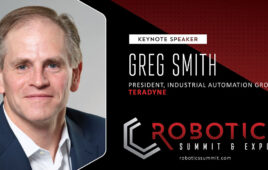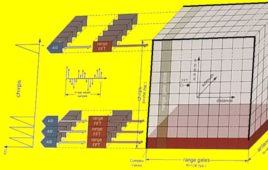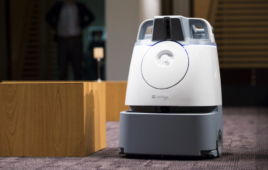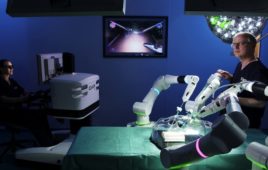
Starship delivery robots on Intuit’s campus. (Credit: Starship Technologies)
Starship Technologies, a delivery robot startup founded in 2015 by two Skype co-founders, is launching its autonomous delivery service at corporate and academic campuses in Europe and the US.
For the last three months, Starship’s six-wheeled robots have been delivering food and office supplies around software company Intuit’s 4.3-acre campus in Mountain View, California. Ahti Heinla, Starship CEO, CTO and co-founder, tells The Robot Report that Starship expects to scale this service to “hundreds of campuses” and about 1,000 robots by the end of 2018.
Starship partnered with Compass Group, the food service company at Intuit’s campus, on this project. There are 10 delivery robots that Compass pays for by the month. Heinla said Intuit’s employees don’t pay extra when they order food or supplies via the Starship app. Heinla said Intuit has a relatively small campus, and that other larger campuses could require 100-plus Starship delivery robots.
According to Starship, it takes about 17 minutes for a delivery to arrive on Intuit’s campus. To date, the most common item carried by a Starship delivery robot on Intuit’s campus has been breakfast sandwiches. “I normally miss breakfast because I’m in a rush on the way to work, but this service has allowed me to have breakfast again, by bringing it to me,” said Ha Ly, Lifecycle Marketing Manager at Intuit.
Starship Delivery Robots Don’t go Indoors
At the moment, the Starship delivery robots only operate outside at Intuit’s campus. As you see in the video above, a worker meets the robot outside, loads it up with food or supplies, and then sends it on its way. When an order is being placed, the customers picks the drop-off location that the Starship delivery robot heads to.
“In the future, perhaps they’ll be working inside buildings,” Heinla said. Certainly that is only a matter of time. Just as delivering on campuses is a natural extension of Starship’s suburban and urban tests, operating the robots indoors only makes sense. One only has to look at Savioke’s Relay robot, among others, to see the success of autonomous indoor deliveries.
Indoor areas such as academic and corporate offices are often far less dynamic than outdoor environments, which makes it easier for the robots to navigate. Starship needs to maps whatever areas the delivery robots operate in, of course. The delivery robots use GPS, radar, cameras and ultrasonic sensors to navigate autonomously.
“Corporate campuses want to transform their work environment to the next level,” Heinla said. “The companies understand that the people doing the work need to have this convenience of working where they want and eating where they want.”
Campuses Offer an Easier Path
Starship delivery robots have made headlines the last few years for a number of tests its conducted with food delivery firms. To date, Starship delivery robots have covered driven about 100,000 miles around the world in 20 countries and over 100 cities.
But this campus roll-out is a major step for the company. As Heinla admits, “none of the efforts by us or others around food delivery in urban areas have been large-scale.”
Private campuses also eliminate the need to get permission from lawmakers and don’t clog up sidewalks. San Francisco recently passed regulations that put severe limits on delivery robots:
- Companies can only test three robots each
- The city is limited to nine delivery robots total
- Delivery robots are confined to industrial areas where almost no one lives
San Francisco, however, seems to be an outlier here as many other cities, including nearby Redwood City and San Jose, have welcomed delivery robots. Heinla said the campus roll-out was always part of Starship’s plan and “totally unrelated” to the recent restrictions implemented in San Francisco.
“The needs of people on corporate campuses are very different,” Heinla said. “In surburban neighborhoods, people don’t order food much because they’re at work. At corporate campuses, it’s vice versa. Food ordering is the most popular ordering service.”
Robotic last-mile delivery is a burgeoning market. McKinsey and Company predicted about 80 percent of last-mile delivery will be carried out by ground robots or delivery drones.
Other ground-based competitors of the Starship delivery robots include Dispatch, Marble, Nuro, and Teleretail. Starship has raised to date around $17 million in funding.
Filed Under: The Robot Report, Robotics • robotic grippers • end effectors





Tell Us What You Think!